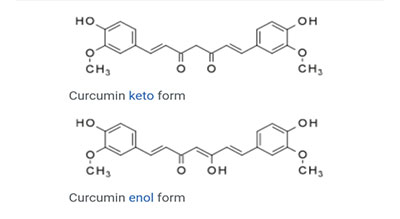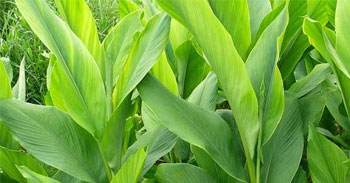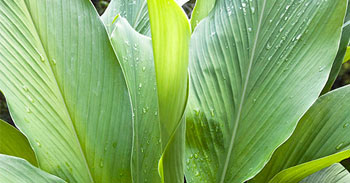KJC Medicinal Garden
Turmeric
Curcuma longa
Order: Zingiberales
Family: Zingiberaceae
Genus: Curcuma
Species: C.longa
Common Names: Tumeric
Native to Indian subcontinent and Southeast Asia, that requires temperatures between 20 and 30 °C
Other plants of the same genus with medicinal properties
-
Curcuma tinctoria Guibourt,
Stissera curcuma Giseke
Curcuma ochrorhiza Valeton
Curcuma soloensis Valeton
- An upright, perennial herb to about 1 m tall. The rhizome (underground stem) is thick and ringed with the bases of old leaves. Turmeric only reproduces via its rhizomes.
- Leaves: Large, oblong, up to 1 m long, dark green on upper surface, pale green beneath. Each leafy shoot (pseudostem) bearing 8-12 leaves.
- Flowers: Yellow-white, borne on a spike-like stalk 10-15 cm long. Flowers are sterile and do not produce viable seed.
- Seeds: Small, ovoid, brown. Not viable.
Uses in Tradition systems of medicine
- Hot water extracts of the dried rhizome have been taken orally in Ayurvedic medicine to reduce inflammation.
- In Unani medicine, turmeric has been used for conditions such as liver obstruction and jaundice and has been applied externally for ulcers and inflammation
- A hot water extract of the dried rhizome taken orally was reputed to slow lactation, regulate fat metabolism, help symptoms of diabetes, diarrhoea and liver diseases, and as a tonic calm the stomach. The fresh juice taken regularly on an empty stomach has been used to prevent stomach disorders
- Externally, the dried rhizome has been applied to fresh wounds and insect stings and to help the healing process in chickenpox and smallpox.
- Turmeric contains more than 300 naturally occurring components including beta-carotene, ascorbic acid (vitamin C), calcium, flavonoids, fiber, iron, niacin, potassium, zinc and other nutrients. But the chemical in turmeric linked to its most highly touted health effects is curcumin.
Suggested Medicinal Properties
- • strong antioxidant
- anti-carcinogenic
- anti-inflammatory
- anti-angiogenic
- antispasmodic
- antimicrobial
- anti-parasites

References
Prianca Reddi. “A Touch of Turmeric: Examining an Ayurvedic Treasure”.Advances in Anthropology 2013. Vol.3, No.2, 91-95.DOI:10.4236/aa.2013.32012
Jelena Stanojević. “Chemical composition, antioxidant and antimicrobial activity of the turmeric essential oil (Curcuma longa L.)”.January 2015Advanced Technologies 4(2):19-25 .DOI:10.5937/savteh1502019S

